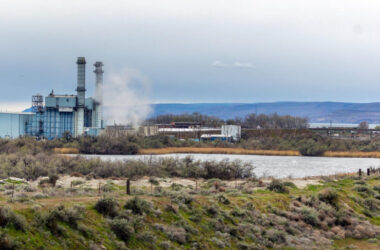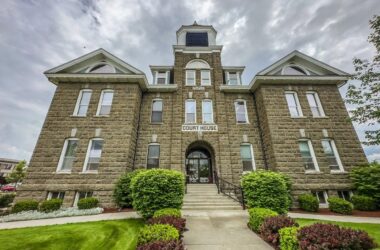For the first time, Boardman residents expressed their frustration and worries about their contaminated water to Gov. Tina Kotek in person.
During an hourlong meeting in the Boardman Senior Center on Wednesday, May 32, dozens discussed their frustration with living with contaminated water for years. They said they had suffered health problems, sometimes losing loved ones to diseases they fear may have been linked to the water.
Mike Pearson said he had been drinking his well water for 30 years, unaware until last summer that it contained more than four times the safe limit of nitrates set by federal authorities.
“When we bought the place they didn’t say a darn thing about nitrate,” Pearson told Kotek at a community meeting at the Boardman Senior Center.
Her visit was the first by an Oregon governor to an area where wells have been contaminated with nitrates for decades, and the first since Morrow County declared a state of emergency over the issue last June. Perhaps thousands of residents in Morrow and Umatilla counties, many of them low-income and Latino, have contaminated well water, but the state has been slow to respond.
Kotek has proposed more than $6 million in aid over the next two years for agency staff, water testing, water delivery and filters.
“I’m not going to stop until you have what you need,” she told them.
Rural organizers say they need at least three times that to spread information, provide safe drinking water and tackle decades of contamination from nitrates found in fertilizers and animal manure and from food processing wastewater spread across farm fields.
Kotek met privately with port officials earlier in the day to discuss the Port of Morrow’s new system for reducing nitrogen levels in its wastewater following more than $2 million in fines last year for violating its permit and contributing to groundwater contamination.
Kotek then joined members of the social and environmental justice group Oregon Rural Action for a late afternoon tour of Boardman, including a visit to the site of a recent wastewater pipeline leak at the port that was flagged by area residents. And she visited the home of a resident whose water contains nearly four times the safe limit of nitrates before the senior center meeting.
Kotek was joined on the hourlong tour of the town by area Rep. Bobby Levy, R-Echo, and state Sen. Bill Hansell, R-Athena. This was the first time they had met directly with residents with contaminated water. Kotek also invited Rep. Greg Smith, R-Heppner, who represents many who live with the groundwater contamination, but he declined to come, according to Anca Matica, a press secretary for the governor. He has not met in person with affected residents, according to Oregon Rural Action organizers.
Thyroid issues and cancer
Nearly everyone who spoke with the governor in the senior center had more than four times the safe limit of nitrates in their drinking water – and several reported health issues they feared could be linked to the contamination.
Pearson said his neighbor, whose family drank their well water for 30 years, lost his wife to lymphoma and that his own wife is struggling with thyroid issues. Several others brought up thyroid issues, lymphoma and other cancers. Jim Partlow had to have half his thyroid removed and is fighting lymphoma.
Research has linked high nitrate consumption over long periods to stomach, bladder and intestinal cancers, miscarriages, as well as thyroid issues, according to the National Cancer Institute and the National Institutes of Health.
But proving a link would be difficult, Kotek and officials at the Oregon Health Authority said, because of a lack of data and research. Kotek has assigned an epidemiologist from the health authority to collect data but doubts any conclusions will be reached.
For many in the crowd, the specter of contaminated water and the influence it might have had on health issues has a powerful grip.
Carlos Jimenez mentioned his wife’s thyroid operation. “I don’t know if it’s because of water contamination or not,” he said.
Kotek heard from 12-year-old Paulo Lopez Jr., who struggled to hold back tears when he talked about losing his grandfather last year, and about his grandmother’s ailing health.
“I wondered if it was the water,” he said.
Residents said the current county commissioners, the Port of Morrow commissioners, locally elected representatives and the state had failed to support them and they asked the governor to “clean house” at the Department of Environmental Quality.
“We have to fix this,” Kotek told them.
Differing budgets
Kotek’s budget includes $5 million for Morrow and Umatilla counties for water testing, bottled water delivery and special filters. She is also proposing $1.2 million for the Department of Environmental Quality to work with a local, volunteer groundwater committee that was created 30 years ago to address nitrate issues, and has done little.
That’s less than half of the $14 million the Legislature gave to Klamath and a few other southern Oregon counties for well-water assistance during the last two years.
Kristin Anderson Ostrom, director of Oregon Rural Action, told Kotek that Morrow and Umatilla counties need a minimum of $18 million for the next two years, with at least $6 million for water deliveries. Currently 180 households receive bottled water deliveries, paid for by the Oregon Department of Human Services. Once testing is more widespread, 10 times as many households might need water deliveries in the next two years, she said.
Kotek said she could probably offer more than $6.2 million but less than $18 million.
Anderson Ostrom also asked Kotek to commit to a widespread public information campaign over the next month, including billboards, radio ads and mailers.
“We still have folks drinking the water; still have folks cooking with the water; still have folks boiling the water,” Anderson Ostrom said. “Every resident in the (area) ought to know the risk in their groundwater and to know that they ought not to drink the water until it’s tested.”
Only about 16% of the estimated 4,500 wells in Morrow and Umatilla counties have been tested.
Kotek declined to make a time commitment but said she and her staff were working as fast as they could and that they’d be back in Boardman soon.
Many residents thanked the governor for visiting, but said they needed to see change, not hear about plans. “I’d like my great grandkids to be able to go to the faucet and drink the water,” said Pearson.
Oregon Capital Chronicle is part of States Newsroom, a network of news bureaus supported by grants and a coalition of donors as a 501c(3) public charity. Oregon Capital Chronicle maintains editorial independence. Contact [email protected]. Follow Oregon Capital Chronicle on Facebook and Twitter.




